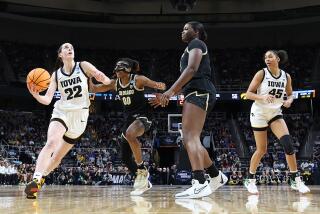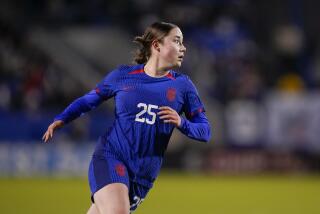Apodaca: With girls joining more sports, safety is growing issue
Some of you may have heard the story of a Utah girl who addressed a school assembly in March and asked if there were any girls who wanted to play tackle football.
That question led to what is being identified as the first-ever girls tackle football league in the United States, which was launched with the blessing of the NFL. The girl who started the ball rolling — or more accurately, passing — 12-year-old Sam Gordon, had become an Internet sensation a few years earlier when a video of her outrunning boys on a football field went viral.
Another girl, 13-year-old Caroline Pla of Pennsylvania, has appeared on Ellen DeGeneres’ talk show to speak about her quest to play football. In a recent Huffington Post piece, she referred to herself as an offensive guard “who takes on mostly boys twice my size.”
At a time when some former NFL players are going public with their concerns over traumatic brain injuries, some even saying they wouldn’t want their children playing the game, Gordon, Pla and other girls suddenly appear to have a good chance of success in their fight to break into what is arguably the most macho American sport.
Forty-three years after Title IX mandated gender equity in every educational program receiving federal funding, including athletics, young girls across the country are now envisioning a not-too-distant future when female athletes finally achieve equity with men.
Signs of change are popping up with increasing regularity. The U.S. Women’s National Team victory over Japan in the Women’s World Cup championship match in July garnered the biggest television audience for any soccer event in U.S. history. In a sport once considered off limits for women, UFC Women’s Bantamweight champ Ronda Rousey has become a genuine superstar. You might have also caught a recent television ad that imagines the first woman to pitch in Major League Baseball.
There’s a lot to like in these stories of girls standing up and demanding to be taken seriously and in the heartwarming sight of them being cheered on by supportive parents who are understandably proud of their daughters’ confidence and courage.
As encouraging as all these displays of girl power can be, however, concerns are also growing that the increasing female involvement in sports poses significant risks. Some studies have already shown that girls, who generally have less head and neck strength, are more prone to concussions than boys, and that these head injuries tend to be more debilitating for them.
Girls also have a higher share of injuries from overuse. And knee problems such as anterior cruciate ligament (ACL) tears are also more common in girls and women.
All of which poses a dilemma for parents. We want our kids to chase their dreams, live up to their potential and partake in valuable exercise, team-building and character-strengthening activities. It’s also worth noting that many activities more traditionally associated with females such as dancing and cheerleading are also notoriously injury plagued, yet they remain an accepted rite of passage for many girls.
But as female athletes continue to push boundaries, how do we balance those pursuits with justifiable concerns over safety?
It’s a question we’ll hear increasingly posed in the days to come. Indeed, many observers are now calling for more research into all sports-related injuries and increased attention given to reducing the rates at which they occur.
The Safe Kids Worldwide survey on youth sports released one year ago had some illuminating, although somewhat disturbing findings. After interviewing 1,000 young athletes, 1,000 parents and more than 1,000 coaches, the researchers reported “an alarming gap in what is being done to keep young athletes safe while playing sports.”
Nine out of 10 kids said they had been injured in a sport, and 54% admitted to playing while injured. What’s more, more than half of the coaches said they’d been pressured by kids and their parents to put young athletes back into games after they’d been injured.
“We’ve definitely been seeing a rise” in sports-related injuries, said Dr. Hien Nghiem, an Irvine-based sports medicine specialist with Hoag Medical Group. And for the past few years, Nghiem said, she has seen an equal number of girls as boys with such injuries.
Nghiem has noticed a cultural aspect to that trend, one of extreme competitiveness contributing to a mindset that athletes should simply tough it out when they experience pain. “I see it in high school and college athletes,” she said. “Both females and males — they just want to play.”
Other contributing factors, she noted, include the growing trend of having kids focus at earlier ages on just one sport, and the prevalence of year-round training, which affords insufficient rest time and can put undo stress on certain body parts. As a result, “we’re seeing a lot of overuse injuries.”
Her advice to parents: “Listen to your children. If they complain of symptoms, take heed and address it.”
Let’s hope such sensible advice isn’t lost in the undeniably justified celebration over female athletic accomplishments and that the quest to have girls be treated just like the boys doesn’t overwhelm good judgement when it comes to injury prevention. Sometimes staying in the game requires sitting one out.
PATRICE APODACA is a former Newport-Mesa public school parent and former Los Angeles Times staff writer. She lives in Newport Beach.
More to Read
A cure for the common opinion
Get thought-provoking perspectives with our weekly newsletter.
You may occasionally receive promotional content from the Los Angeles Times.







